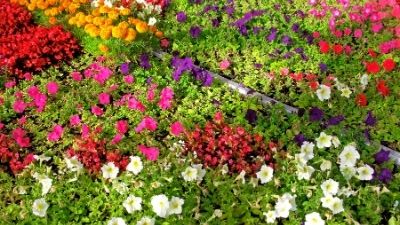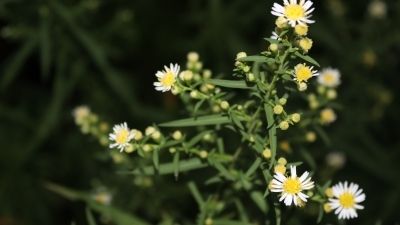Annuals for Utah Gardens

Annuals are plants that come up in the spring, reach maturity, flower, set seeds, then die all in one season. They provide eye-catching color to any flower bed and can be used as borders, fillers, or background plantings. There are several ways to find annual species that fit your landscape needs; referring to the All-American Selection program evaluations (http://www.all-americaselections.org), visiting botanical gardens to observe examples of annuals in the landscape, and looking through commercial seed catalogs are excellent places to find ideas.
Most annuals are available in cell packs, flats, or individual pots. When buying plants, choose those that are well established but not pot bound. Tall spindly plants lack vigor and should be avoided. Instead look for plants with dark green foliage that are compact and free of insect and disease problems. These criteria are much more important than the flower number when choosing a plant. An abundance of foliage with few, if any flowers, is desirable.
Bed Preparation
Avoid cultivating soil too early in the spring and during conditions that are too wet. Soil conditions can be determined by feeling the soil. If the soil forms a ball in your hand but crumbles easily, it is ideal. Cultivate the flower bed to a depth of 6-10 inches by turning the soil with a spade. Utah soils can always use extra organic matter such as grass clippings, leaves, compost, manure, peat, etc. About 1 inch of compost can be added and tilled into the bed. Fertilizer should be applied based on soil test results. However, if you choose not to test the soil, add a complete fertilizer that is higher in nitrogen at a rate of 1 to 2 pounds of nitrogen per 1000 square feet of cultivated area or add a complete slow-release fertilizer based on the label directions. Fertilizers should be incorporated into the top 4-6 inches of soil.
Transplanting
Annuals prefer warm soil and should not be planted until the threat of frost has past. Planting dates will vary throughout the state.
Refer to the freeze-free dates (Table 1) or talk to your local county Extension agent about planting dates for your area. It is best to transplant in early morning or evening when temperatures are cooler and transplant shock is minimized. If the plants in the cell packs or pots are extremely root bound, gently loosen the roots on the sides of the root ball. Make sure the root ball of the plant is moist when planting to reduce wilting. Position the plant in the bed at the same depth as it was in the original pot. Plants placed too deep in the soil can encourage disease problems and those planted too high may fall over. Keep soil around the plants moist for about a week after transplanting or until the root system establishes and new top growth is observed. Mulch between plants to reduce potential weed problems and to conserve moisture by limiting water evaporation from the soil.
Watering
Once established, allow the soil surface to dry slightly between irrigations. Irrigate until the soil is thoroughly moistened to 6 inches below the surface. This stimulates deeper root growth. Annual beds require less irrigation than turf and should be watered separately. Irrigation systems that reduce water accumulation on the foliage and flowers are recommended.
Table 1. Average last spring and first fall freeze days.
| Location | Avg. last spring freeze | Avg. first fall freeze | Avg. freeze free days |
|---|---|---|---|
| Beaver | June 4 | Sept 16 | 104 |
| Blanding | May 14 | Oct 11 | 149 |
| Castle Dale | May 22 | Sept 23 | 124 |
| Cedar City | May 19 | Oct 2 | 135 |
| Coalville | June 15 | Sept 2 | 78 |
| Corinne | May 13 | Sept 29 | 139 |
| Delta | May 16 | Sept 28 | 135 |
| Farmington | May 5 | Oct 10 | 158 |
| Heber | June 8 | Sept 7 | 90 |
| Kanab | May 4 | Oct 23 | 171 |
| Logan | May 25 | Sept 25 | 158 |
| Manti | May 22 | Sept 27 | 127 |
| Moab | April 18 | Oct 16 | 181 |
| Nephi | May 15 | Oct 1 | 138 |
| Ogden | May 5 | Oct 10 | 157 |
| Panguitch | June 20 | Sept 2 | 74 |
| Pleasant Grove | May 11 | Oct 9 | 151 |
| Richfield | May 26 | Sept 19 | 116 |
| Roosevelt | May 15 | Sept 27 | 134 |
| St. George | March 29 | Nov 1 | 216 |
| Salt Lake City | April 26 | Oct 16 | 172 |
| Tooele | May 3 | Oct 15 | 164 |
| Vernal | May 27 | Sept 20 | 116 |
Suggested Drought Tolerant Annuals for Utah
- Ageratum (Ageratum houstonianum)
- Blanket Flower (Gaillardia pulchella)
- Cockscomb (Celosia cristata)
- Cosmos (Cosmos bipinnatus and C. sulphureus)
- Dusty Miller (Senecio cineraria)
- Flowering Tobacco (Nicotiana alata)
- Four o’clocks (Mirabilis jalapa)
- Gazania (Gazania splendens)
- Globe amaranth (Gomphrena globosa)
- Lantana (Lantana camara and L. montevidemis)
- Vinca (Catharanthus roseus)
- Rose Moss (Portulaca grandiflora)
- Marigold (Tagetes erecta and T. patula)
- Mexican sunflower (Tithonia rotundifolia)
- Salvia (Salvia splendens and S. farinacea)
- Statice (Limonium species)
- Strawflower (Helichrysum bracteatum)
- Spider Plant (Cleome hasslerana)
- Sunflower (Helianthus annuus)
- Sweet alyssum (Lobularia maritime)
- Verbena (Verbena species)
- Zinnia (Zinnia angustifolia, Z. elegans, and Z. linearis)
References
- Ashcroft, G.L., D.T. Jensen and J.L. Brown. 1992. Utah climate. Utah Climate Center Utah State University, Logan, Utah.
- Bailey, D.A., and M.A. Powell. 1999. Installation and maintenance of landscape bedding plants. North Carolina State University HIL #555. http://www.ces.ncsu.edu/depts/hort/floriculture/hils/hil555.html
- Hoffman J.R. 1978. Annual flowers for Utah’s landscape. Utah State University Extension.
- Lopes, P., and T. Smith. 2002. Floriculture Extension Drought Bulletin. University of Massachusetts Extension. http://www.umass.edu/umext/programs/agro/floriculture/floral_facts/drought.html
- University of Illinois Extension. Gardening with Annuals. http://www.urbanext.uiuc.edu/annuals/
Related Research



